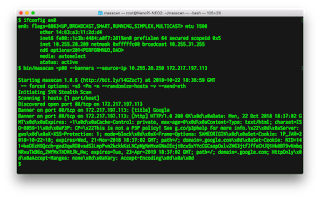IoT Tales of Horror (Inspired by Real-Life Events)

Happy Halloween! In some parts of the world, people are celebrating this holiday of horror by dressing up as monsters or other frights and watching scary movies. But sometimes these tales can be just a little boring. Pod people? Headless horsemen? Replicant children? Whatever.
I present the real horror stories of Halloween – and every other day of the year. These tales are inspired by real-life events and are guaranteed to give you a chill. (And not just because your smart thermostat is being controlled by a shapeshifting clown who lives in the sewer!)

I(o)T
In the fall of 2018, a group of kids work together to destroy an evil malware, which infects connected toys and preys on the children of their small town.
Inspired by the terrifying vulnerabilities found in everyday connected toys.
Night of the Living Devices
There’s panic across the Internet as connected devices suddenly begin attacking critical Internet infrastructure. The film follows a group of network operators as they frantically work to protect the Internet from these packet spewing, infected devices.
Inspired by the harrowing events of the 2016 Dyn attack.
 Rosemary’s Baby Monitor
Rosemary’s Baby Monitor
A young family moves into a house billed as the “smart Continue reading
MEF Releases SD-WAN Technical Specification to Its Members
 MEF aims for its SD-WAN service standardization to accelerate sales of SD-WAN products and services like MEF accomplished with Carrier Ethernet service standardization.
MEF aims for its SD-WAN service standardization to accelerate sales of SD-WAN products and services like MEF accomplished with Carrier Ethernet service standardization.
Deploying Secure Kubernetes Containers in Production: Thwarting the Threats
 Once you have containers in production certain security measures must be put in place to cover network filtering, container inspection, and host security.
Once you have containers in production certain security measures must be put in place to cover network filtering, container inspection, and host security.
Oracle Cloud Tech Seems Solid. But Is It Too Late?
 The company’s got about a year to turn around its Oracle cloud business if it’s going to meet its lofty goals.
The company’s got about a year to turn around its Oracle cloud business if it’s going to meet its lofty goals.
Systemd is bad parsing and should feel bad
Systemd has a remotely exploitable bug in it's DHCPv6 client. That means anybody on the local network can send you a packet and take control of your computer. The flaw is a typical buffer-overflow. Several news stories have pointed out that this client was written from scratch, as if that were the moral failing, instead of reusing existing code. That's not the problem.Trump Wants a National 5G Spectrum Policy
 The president issued a memorandum that is intended to make more spectrum available so that operators can more quickly deploy 5G.
The president issued a memorandum that is intended to make more spectrum available so that operators can more quickly deploy 5G.
Join Us: Immerse Yourself in Networking and Security at VMworld Europe
We are looking forward to a fantastic show at VMworld 2018 Europe. We have a ton of great content on networking and security to share with you including breakouts, labs, activities, and parties! You’ll have prime opportunities to learn about the Virtual Cloud Network, the latest on the NSX product portfolio, and network with your peers and VMware experts.
To get you started for a packed week of learning and fun, we highly recommend attending our two showcase keynotes:
First, at the NSX Keynote: Building the Network of the Future with the Virtual Cloud Network (Tuesday, 06 November, 14:00 – 15:00), you’ll hear Tom Gillis, the new GM of NSBU lead discussions on:
- VMware’s vision for networking with the Virtual Cloud Network
- The latest and greatest innovations across the NSX product portfolio
- Joint solutions we are bringing to the cloud with IBM
- A special conversation with key customers about how they are using NSX today
- And, demonstrations showing the entire product portfolio in action including NSX Data Center, NSX Cloud, NSX SD-WAN by VeloCloud, and AppDefense

Next, at the Security Keynote: Transforming Security in a Cloud and Mobile World, (Wednesday, 07 November, 14:00 – 15:00), Tom Corn, Continue reading
Check Point Buys Cloud Security Startup Dome9 for $175 Million
 Dome9’s platform will add new capabilities — specifically cloud management and policy enforcement — to Check Point’s recently launched CloudGuard product portfolio.
Dome9’s platform will add new capabilities — specifically cloud management and policy enforcement — to Check Point’s recently launched CloudGuard product portfolio.
Alibaba Cloud Brings Its Blockchain Service to the Global Stage
 The blockchain service is based on the Linux Foundation’s Hyperledger Fabric and the Alibaba Group financial affiliate’s blockchain platform.
The blockchain service is based on the Linux Foundation’s Hyperledger Fabric and the Alibaba Group financial affiliate’s blockchain platform.
Cisco, Nokia, Microsoft Back $85M Team8-Led Security Fund
 These investors and other major companies also joined a Team8-led coalition that aims to rethink security by building it into network and cloud infrastructure.
These investors and other major companies also joined a Team8-led coalition that aims to rethink security by building it into network and cloud infrastructure.
Samsung, NEC Join Forces on 5G
 The partnership will provide Samsung with access to the Japanese market and NEC with its first hardware foray outside of its home market.
The partnership will provide Samsung with access to the Japanese market and NEC with its first hardware foray outside of its home market.
NSX at VMworld 2018 Europe – The Technical Session Guide
Hola! VMworld 2018 Europe is around the corner and we look forward to connecting with our VMware NSX community in Barcelona. Before we go into session recommendations, let us give you a recap on what we have been up to since VMworld US.
Since VMworld US in August 2018, we have announced general availability for NSX-T Data Center 2.3. NSX-T Data Center 2.3 extends NSX platform support to Bare Metal servers, enhances multi-cloud control in AWS & Azure, advances security with N/S service insertion, and has many more enhancements.
Our friends from vSphere have also released vSphere 6.7 Update 1 which gives NSX-T N-VDS visualization in the vCenter now.
For automation fans, we have a Concourse CI pipeline which automates the NSX-T install. This pipeline can be used to stand up entire NSX-T environments on vSphere clusters by filing a simple parameter file.
NSX-T Concourse Pipeline information
Now, let’s talk about our VMworld Europe line-up. As usual, we have great technical deep-dives, deployment stories, and hands-on labs for you. For the technical enthusiasts who are interested in deep-dives and deployment strategies, here are a set of “geek” sessions to choose Continue reading
Masscan as a lesson in TCP/IP
When learning TCP/IP it may be helpful to look at the masscan port scanning program, because it contains its own network stack. This concept, "contains its own network stack", is so unusual that it'll help resolve some confusion you might have about networking. It'll help challenge some (incorrect) assumptions you may have developed about how networks work.Fortinet Buys ZoneFox, a Security Startup That Hunts for Insider Threats
 The company’s software enables organizations to see where business-critical data is going and if people are doing things with it that they shouldn’t be – either accidentally or maliciously.
The company’s software enables organizations to see where business-critical data is going and if people are doing things with it that they shouldn’t be – either accidentally or maliciously.
Oracle Buys DataFox, Pledges to Embed AI Into Everything
 Oracle co-CEO Mark Hurd predicted that by 2025 all cloud apps will include artificial intelligence. And likely because of this AI strategy, the company reached a deal to acquire DataFox and its cloud-based AI data engine.
Oracle co-CEO Mark Hurd predicted that by 2025 all cloud apps will include artificial intelligence. And likely because of this AI strategy, the company reached a deal to acquire DataFox and its cloud-based AI data engine.
How to Balance Cloud-Scale Efficiencies Against Business Realities
 The widespread deployment of cloud infrastructure has led IT teams to demand freedom of choice, but that might not always be what’s best for the organization as a whole.
The widespread deployment of cloud infrastructure has led IT teams to demand freedom of choice, but that might not always be what’s best for the organization as a whole.
Oracle Brings ‘Star Wars Cyber Defenses’ and Robots to Cloud Security
 The company's new cloud architecture features "impenetrable barriers" that block threats and autonomous robots that find threats and kill them, said CTO Larry Ellison.
The company's new cloud architecture features "impenetrable barriers" that block threats and autonomous robots that find threats and kill them, said CTO Larry Ellison.
Some notes for journalists about cybersecurity
The recent Bloomberg article about Chinese hacking motherboards is a great opportunity to talk about problems with journalism.Journalism is about telling the truth, not a close approximation of the truth, but the true truth. They don't do a good job at this in cybersecurity.
Take, for example, a recent incident where the Associated Press fired a reporter for photoshopping his shadow out of a photo. The AP took a scorched-earth approach, not simply firing the photographer, but removing all his photographs from their library.
That's because there is a difference between truth and near truth.
Now consider Bloomberg's story, such as a photograph of a tiny chip. Is that a photograph of the actual chip the Chinese inserted into the motherboard? Or is it another chip, representing the size of the real chip? Is it truth or near truth?
Or consider the technical details in Bloomberg's story. They are garbled, as this discussion shows. Something like what Bloomberg describes is certainly plausible, something exactly what Bloomberg describes is impossible. Again there is the question of truth vs. near truth.
There are other near truths involved. For example, we know that supply chains often replace high-quality expensive components with cheaper, Continue reading
Pulumi Code Dev Platform Adds Premium Team Tier, Scores $15M Series A
 The firm's SaaS platform acts as a translation layer between the language a developer is using to write code and where that code is being sent.
The firm's SaaS platform acts as a translation layer between the language a developer is using to write code and where that code is being sent.
What Makes a Security Company?

When you think of a “security” company, what comes to mind? Is it a software house making leaps in technology to save us from DDoS attacks or malicious actors? Maybe it’s a company that makes firewalls or intrusion detection systems that stand guard to keep the bad people out of places they aren’t supposed to be. Or maybe it’s something else entirely.
Tradition Since Twenty Minutes Ago
What comes to mind when you think of a traditional security company? What kinds of technology do they make? Maybe it’s a firewall. Maybe it’s an anti-virus program. Or maybe it’s something else that you’ve never thought of.
Is a lock company like Schlage a security company? Perhaps they aren’t a “traditional” IT security company but you can guarantee that you’ve seen their products protecting data centers and IDF closets. What about a Halon system manufacturer? They may not be a first thought for security, but you can believe that a fire in your data center is going cause security issues. Also, I remember that I learned more about Halon and wet/dry pipe fire sprinkler systems from my CISSP study than anywhere else.
The problem with classifying security companies as “traditional” or “non-traditional” Continue reading

